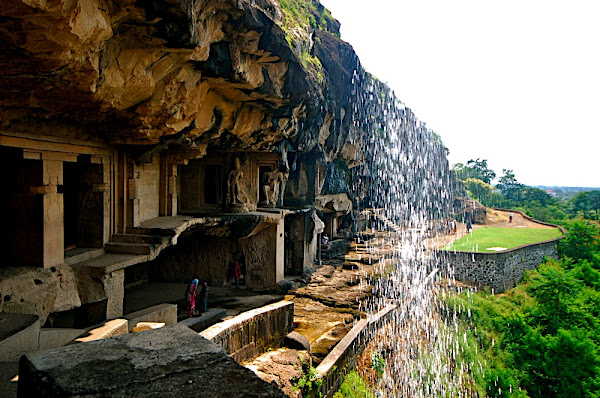Ellora is located 30 km (19 miles) away from Aurangabad and we visited it during the same trip during which we went to the Ajanta Caves. Both cave complexes are very impressive and I would not be able to name the one that I liked more. The Ajanta Caves are in the more pristine location, see less tourists, and have better preserved frescoes. On the other hand, the Kailsanatha Temple in Ellora is the most spectacular of all the cave-temples we saw. I also thought that it was great that in Ellora we could directly compare Buddhist, Hindu and Jain temples (all temples in Ajanta are Buddhist).
The Ellora Caves were excavated out of the cliff of the Charanandri hills between the 5th century and 10th century, during the reign of the Rashtrakuta dynasty. There are 12 Buddhist (caves numbered 1 to 12), 17 Hindu (caves 13–29) and 5 Jain (30–34) caves.
The most impressive cave in the complex is the Hindu Kailasantha Temple (Cave No 16), to which I dedicated a separate post. But also other Hindu temples are very beautiful, each in its own way. They represent different styles and some of them are so complex that they must have taken several centuries to be completed.
The most famous of the Buddhist caves is Cave No 10, a chaitya hall or 'Vishvakarma cave', popularly known as the "Carpenter's Cave". At its heart is an impressive 15-foot statue of Buddha seated in a preaching pose. Most of the Buddhist Caves are large, multi-storied, and included living and sleeping quarters, kitchens, and other rooms.
In contrast to the majestic Hindu and Buddhist Caves, the five Jain Caves are small and have ascetic feel to them. They do have, however, more intricate and exceptionally detailed art works. Also, many of the structures had rich paintings in the ceilings – fragments of which are still visible.
Buddhist Caves
The central statue in the Cave No 10:


A waterfall and caves No 1 to 5:


Cave No 5:

Hindu Caves
Cave No 15:

Sculptures in the Cave No 15:

Side statues in the Cave No 21:

Side statues in the Cave No 21:

Side statues in the Cave No 21:

Views from the Cave No 26:

A waterfall and Caves No 25 and 26:

Cave No 29:

Jain Caves
Cave No 32:

Sculptures in the Cave No 32:

The central statue in the Cave No 32:

Side sculptures in the Cave No 32:

Side sculptures in the Cave No 32:

Cave No 32:

Side sculptures in the Cave No 32:

Cave No 34:
